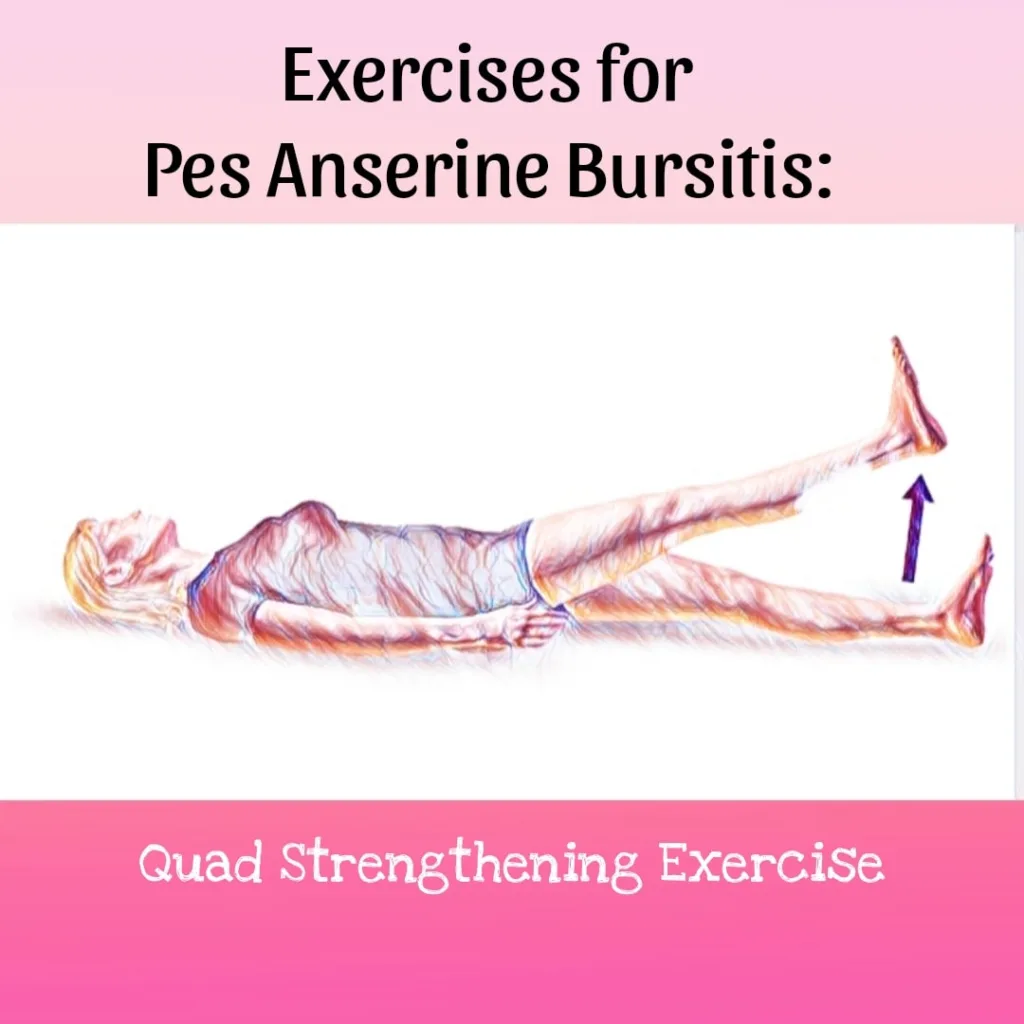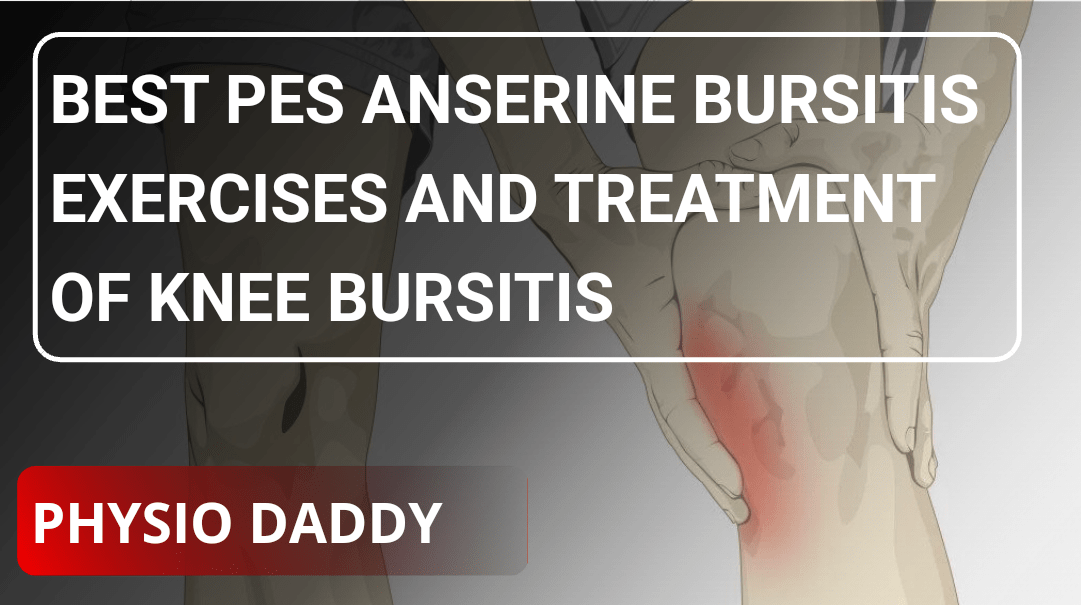Pes Anserine Bursitis is a condition that involves inflammation of the pes anserine bursa, a small, lubricating sac located between the shinbone and the three tendons of the hamstring muscles.
Pes Anserine Bursitis can cause pain, swelling, and discomfort on the inner side of the knee.
In this blog post, we’ll explore some of the best exercises and treatment options to manage Pes Anserine Bursitis and alleviate knee bursitis symptoms.
Understanding Pes Anserine Bursitis:
Pes Anserine Bursitis often results from overuse, trauma, or biomechanical issues. Common symptoms include pain, tenderness, and swelling on the inner knee. It is crucial to seek professional medical advice for an accurate diagnosis before starting any exercise or treatment regimen.
Exercises for Pes Anserine Bursitis:
1. Quad Strengthening Exercises:

- Activity: Leg lifts involve lying on your back and lifting one leg at a time, engaging the quadriceps.
- Benefits: These exercises contribute to the stabilization of the knee joint by strengthening the quadriceps, providing support and reducing stress on the bursa.
- Caution: Ensure proper form, keeping the movements controlled and avoiding any jerky motions. It’s advisable to perform these exercises under supervision, especially if you’re new to them.
2. Low-Impact Cardio:

- Activities: Swimming and cycling are excellent low-impact cardiovascular exercises.
- Benefits: Engaging in these activities promotes cardiovascular health without subjecting the knee joint to excessive stress, making them ideal for individuals with Pes Anserine Bursitis.
- Caution: Choose activities that feel comfortable and avoid high-impact exercises. Listen to your body, and if you experience pain, consult with a healthcare professional.
3. Calf Raises:

- Activity: Stand with feet hip-width apart and raise your heels off the ground, lifting your body weight onto the balls of your feet.
- Benefits: Calf raises strengthen the calf muscles, providing additional support to the knee joint.
- Caution: Start with a manageable number of repetitions and gradually increase. Avoid locking your knees during the exercise and prioritize controlled movements.
4. Inner Thigh Strengthening:

- Activity: Adductor squeezes involve squeezing a ball or a cushion between your knees, while side leg lifts target the inner thigh muscles.
- Benefits: Strengthening the inner thigh muscles helps create a better balance of muscle strength around the knee, supporting the affected bursa.
- Caution: Perform these exercises with control and precision to avoid unnecessary strain. Use a comfortable resistance level and increase gradually.
5. Hamstring Stretching:

- Activity: Dynamic stretches like leg swings and static stretches where you sit and reach for your toes.
- Benefits: Dynamic stretches improve flexibility, while static stretches help reduce strain on the pes anserine bursa by enhancing the overall flexibility of the hamstring muscles.
- Caution: Execute stretches gently and avoid overexertion, particularly if you feel any discomfort. Gradually increase the intensity of stretching as your flexibility improves.
Treatment Options for Pes Anserine Bursitis:
1. Rest and Ice:
- Procedure: Allow sufficient time for rest, avoiding activities that worsen symptoms. Apply ice packs to the affected area for 15-20 minutes at intervals.
- Benefits: Rest minimizes stress on the bursa, and ice helps reduce inflammation and alleviate pain.
- Caution: Ensure proper application of ice to prevent skin irritation. Follow recommended rest periods as advised by a healthcare professional.
2. Anti-Inflammatory Medications:
- Type: Nonsteroidal anti-inflammatory drugs (NSAIDs) like ibuprofen or naproxen.
- Benefits: Medications help manage pain and reduce inflammation associated with Pes Anserine Bursitis.
- Caution: Consult with a healthcare professional before using any medication to determine the appropriate dosage and potential side effects.
3. Physical Therapy:
- Approach: A physical therapist designs a customized exercise program targeting specific muscle imbalances and provides manual therapy.
- Benefits: Physical therapy addresses underlying issues, enhances strength, and improves biomechanics to alleviate Pes Anserine Bursitis symptoms.
- Caution: Follow the therapist’s recommendations carefully and communicate any discomfort or changes during sessions.
4. Ultrasound Therapy:
- Procedure: The application of ultrasound waves to stimulate healing and reduce inflammation in the pes anserine bursa.
- Benefits: Ultrasound therapy can enhance the recovery process and alleviate pain.
- Caution: Administered by trained professionals, ultrasound therapy should be part of an overall treatment plan and not a standalone solution.
5. Corticosteroid Injections:
- Administration: Injecting corticosteroids directly into the pes anserine bursa.
- Benefits: Provides targeted relief by reducing inflammation in the affected area.
- Caution: Reserved for more severe cases and should only be administered by a qualified healthcare professional. Potential side effects and long-term considerations should be discussed.
Conclusion:
Pes Anserine Bursitis can be effectively managed through a combination of targeted exercises and appropriate treatment modalities. However, it is crucial to consult with a healthcare professional to determine the most suitable approach based on individual circumstances. By incorporating these exercises and treatments into your routine, you can work towards reducing pain, promoting healing, and improving overall knee function.
Also Read – Pes anserine bursitis exercises to avoid


